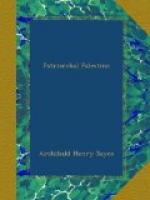Long before the days of the nineteenth dynasty, however, there had been Egyptian travellers in Palestine, or at least in the adjoining countries. One of the Egyptian books which have come down to us contains the story of a certain Sinuhit who had to fly from Egypt in consequence of some political troubles in which he was involved after the death of Amon-m-hat I. of the twelfth dynasty. Crossing the Nile near Kher-ahu, the Old Cairo of to-day, he gained the eastern bank of the river and made his way to the line of forts which protected Egypt from its Asiatic enemies. Here he crouched among the desert bushes till night-fall, lest “the watchmen of the tower” should see him, and then pursued his journey under the cover of darkness. At daybreak he reached the land of Peten and the wadi of Qem-uer on the line of the modern Suez Canal. There thirst seized upon him; his throat rattled, and he said to himself—“This is the taste of death.” A Bedawi, however, perceived him and had compassion on the fugitive: he gave him water and boiled milk, and Sinuhit for a while joined the nomad tribe. Then he passed on to the country of Qedem, the Kadmonites of the Old Testament (Gen. xv. 19; Judges vi. 3), whence came the wise men of the East (1 Kings iv. 30). After spending a year and a half there, ’Ammu-anshi, the prince of the Upper land of Tenu, asked the Egyptian stranger to come to him, telling him that he would hear the language of Egypt. He added that he had already heard about Sinuhit from “the Egyptians who were in the country.” It is clear from this that there had been intercourse for some time between Egypt and “the Upper Tenu.”
It is probable that Dr. W. Max Mueller is right in seeing in Tenu an abbreviated form of Lutennu (or Rutenu), the name by which Syria was known to the Egyptians. There was an Upper Lutennu and a Lower Lutennu, the Upper Lutennu corresponding with Palestine and the adjoining country, and thus including the Edomite district of which ’Ammu-anshi or Ammi-anshi was king. In the name of ’Ammu-anshi, it may be observed, we have the name of the deity who appears as Ammi or Ammon in the kingdom of the Ammonites, and perhaps forms the second element in the name of Balaam. The same divine name enters into the composition of those of early kings of Ma’in in Southern Arabia, as well as of Babylonia in the far East. (See above, p. 64.)




